ABS YAMAHA XV1600A 2001 Owners Manual
[x] Cancel search | Manufacturer: YAMAHA, Model Year: 2001, Model line: XV1600A, Model: YAMAHA XV1600A 2001Pages: 104, PDF Size: 20.37 MB
Page 13 of 104
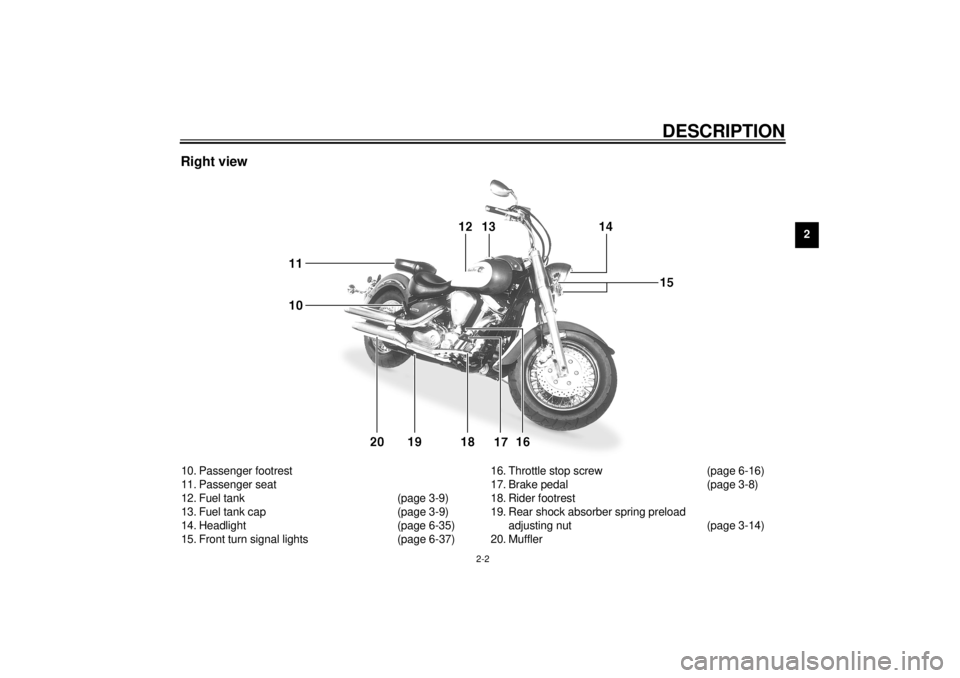
DESCRIPTION
2-2
2
Right view10. Passenger footrest
11. Passenger seat
12. Fuel tank (page 3-9)
13. Fuel tank cap (page 3-9)
14. Headlight (page 6-35)
15. Front turn signal lights (page 6-37)16. Throttle stop screw (page 6-16)
17. Brake pedal (page 3-8)
18. Rider footrest
19. Rear shock absorber spring preload
adjusting nut (page 3-14)
20. Muffler
E_5JA.book Page 2 Wednesday, September 13, 2000 6:06 PM
Page 15 of 104
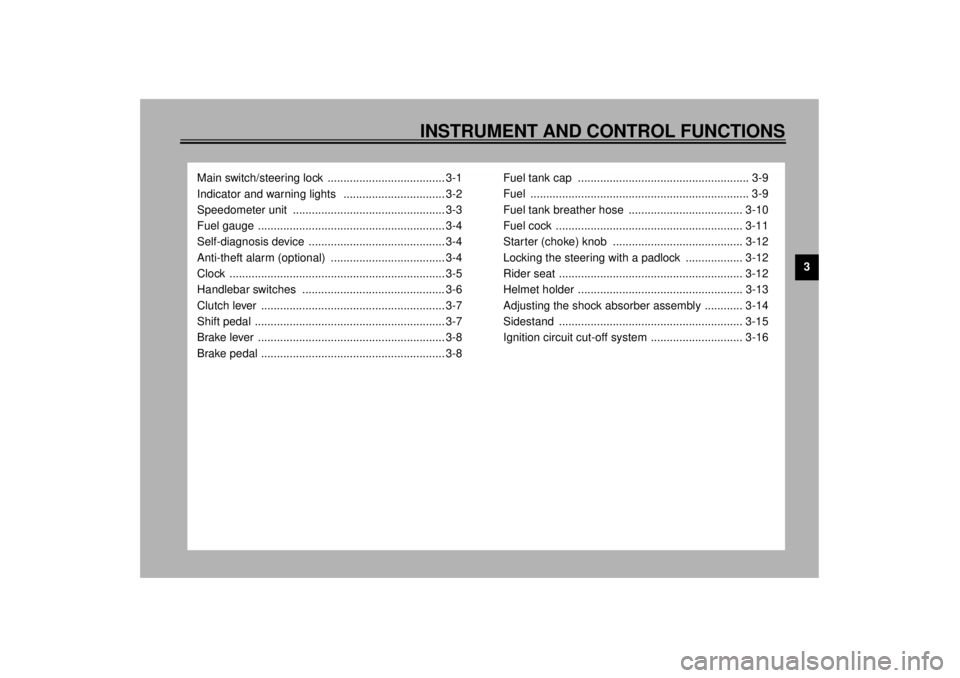
3
INSTRUMENT AND CONTROL FUNCTIONS
Main switch/steering lock ..................................... 3-1
Indicator and warning lights ................................ 3-2
Speedometer unit ................................................ 3-3
Fuel gauge ........................................................... 3-4
Self-diagnosis device ........................................... 3-4
Anti-theft alarm (optional) .................................... 3-4
Clock .................................................................... 3-5
Handlebar switches ............................................. 3-6
Clutch lever .......................................................... 3-7
Shift pedal ............................................................ 3-7
Brake lever ........................................................... 3-8
Brake pedal .......................................................... 3-8Fuel tank cap ...................................................... 3-9
Fuel ..................................................................... 3-9
Fuel tank breather hose .................................... 3-10
Fuel cock ........................................................... 3-11
Starter (choke) knob ......................................... 3-12
Locking the steering with a padlock .................. 3-12
Rider seat .......................................................... 3-12
Helmet holder .................................................... 3-13
Adjusting the shock absorber assembly ............ 3-14
Sidestand .......................................................... 3-15
Ignition circuit cut-off system ............................. 3-16
E_5JA.book Page 1 Wednesday, September 13, 2000 6:06 PM
Page 29 of 104
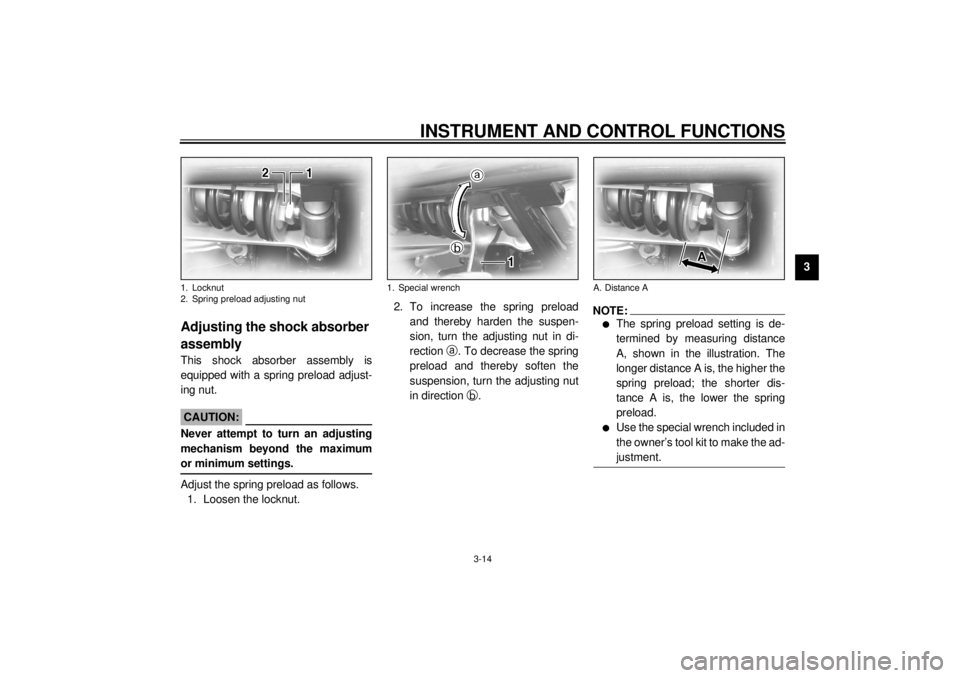
INSTRUMENT AND CONTROL FUNCTIONS
3-14
3
EAU01694*
Adjusting the shock absorber
assembly This shock absorber assembly is
equipped with a spring preload adjust-
ing nut.
EC000015
CAUTION:@ Never attempt to turn an adjusting
mechanism beyond the maximum
or minimum settings. @Adjust the spring preload as follows.
1. Loosen the locknut.2. To increase the spring preload
and thereby harden the suspen-
sion, turn the adjusting nut in di-
rection
a. To decrease the spring
preload and thereby soften the
suspension, turn the adjusting nut
in direction
b.
NOTE:@ l
The spring preload setting is de-
termined by measuring distance
A, shown in the illustration. The
longer distance A is, the higher the
spring preload; the shorter dis-
tance A is, the lower the spring
preload.
l
Use the special wrench included in
the owner’s tool kit to make the ad-
justment.
@
1. Locknut
2. Spring preload adjusting nut
1. Special wrench
A. Distance A
E_5JA.book Page 14 Wednesday, September 13, 2000 6:06 PM
Page 30 of 104
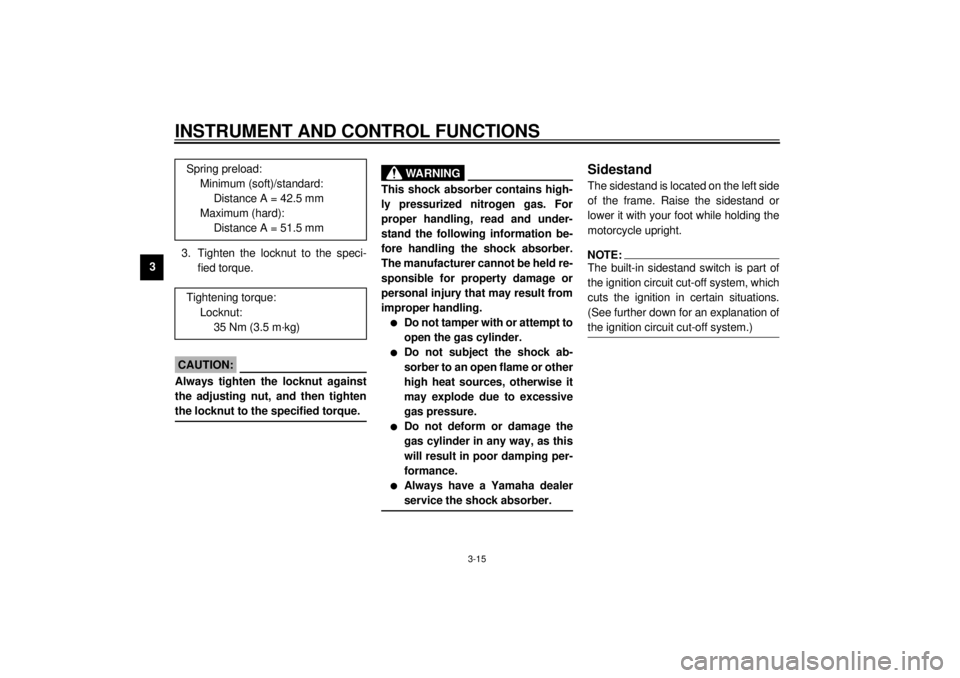
INSTRUMENT AND CONTROL FUNCTIONS
3-15
33. Tighten the locknut to the speci-
fied torque.
EC000018
CAUTION:@ Always tighten the locknut against
the adjusting nut, and then tighten
the locknut to the specified torque. @
EAU00315
WARNING
@ This shock absorber contains high-
ly pressurized nitrogen gas. For
proper handling, read and under-
stand the following information be-
fore handling the shock absorber.
The manufacturer cannot be held re-
sponsible for property damage or
personal injury that may result from
improper handling.l
Do not tamper with or attempt to
open the gas cylinder.
l
Do not subject the shock ab-
sorber to an open flame or other
high heat sources, otherwise it
may explode due to excessive
gas pressure.
l
Do not deform or damage the
gas cylinder in any way, as this
will result in poor damping per-
formance.
l
Always have a Yamaha dealer
service the shock absorber.
@
EAU00330
Sidestand The sidestand is located on the left side
of the frame. Raise the sidestand or
lower it with your foot while holding the
motorcycle upright.NOTE:@ The built-in sidestand switch is part of
the ignition circuit cut-off system, which
cuts the ignition in certain situations.
(See further down for an explanation of
the ignition circuit cut-off system.) @
Spring preload:
Minimum (soft)/standard:
Distance A = 42.5 mm
Maximum (hard):
Distance A = 51.5 mm
Tightening torque:
Locknut:
35 Nm (3.5 m·kg)
E_5JA.book Page 15 Wednesday, September 13, 2000 6:06 PM
Page 49 of 104

PERIODIC MAINTENANCE AND MINOR REPAIR
6-4
6
9
*Brake hoses• Check for cracks or damage.ÖÖÖÖ Ö
• Replace. (See NOTE on page 6-5.) Every 4 years
10*Wheels• Check runout, spoke tightness and for damage.
• Tighten spokes if necessary.ÖÖÖÖ
11*Tires• Check tread depth and for damage.
• Replace if necessary.
• Check air pressure.
• Correct if necessary.ÖÖÖÖ
12*Wheel bearings• Check bearing for looseness or damage.ÖÖÖÖ
13*Swingarm• Check operation and for excessive play.ÖÖÖÖ
• Lubricate with molybdenum disulfide grease. Every 50,000 km
14*Drive belt• Check belt tension.
• Make sure that the rear wheel is properly aligned.Every 4,000 km
15*Steering bearings• Check bearing play and steering for roughness.ÖÖÖÖÖ
• Lubricate with lithium-soap-based grease. Every 20,000 km
16*Chassis fasteners• Make sure that all nuts, bolts and screws are properly tightened.ÖÖÖÖ Ö
17 Sidestand• Check operation.
• Lubricate.ÖÖÖÖ Ö
18*Sidestand switch• Check operation.ÖÖÖÖÖ Ö
19*Front fork• Check operation and for oil leakage.ÖÖÖÖ
20*Rear shock absorber
assembly• Check operation and shock absorber for oil leakage.ÖÖÖÖ
21*Rear suspension relay
arm and connecting arm
pivoting points• Check operation.ÖÖÖÖ
• Lubricate with molybdenum disulfide grease.ÖÖ
22*Carburetors• Check starter (choke) operation.
• Adjust engine idling speed and synchronization.ÖÖÖÖÖ Ö NO. ITEM CHECK OR MAINTENANCE JOBODOMETER READING (´1,000 km)
ANNUAL
CHECK
1 10203040
E_5JA_Periodic.fm Page 4 Monday, December 18, 2000 7:28 PM
Page 88 of 104
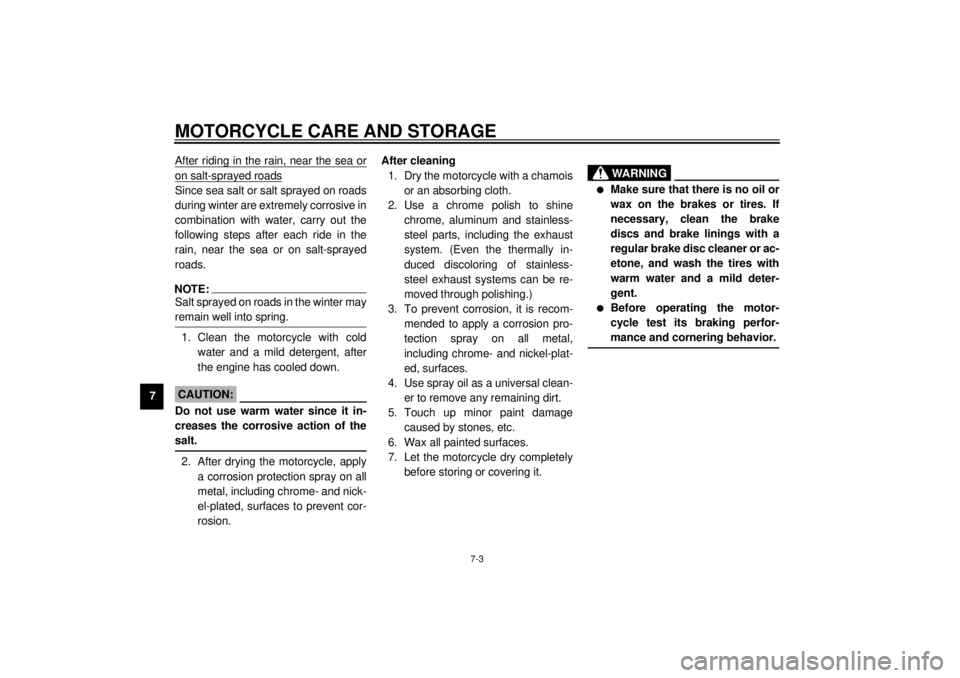
MOTORCYCLE CARE AND STORAGE
7-3
7After riding in the rain, near the sea or
on salt-sprayed roadsSince sea salt or salt sprayed on roads
during winter are extremely corrosive in
combination with water, carry out the
following steps after each ride in the
rain, near the sea or on salt-sprayed
roads.NOTE:@ Salt sprayed on roads in the winter may
remain well into spring. @1. Clean the motorcycle with cold
water and a mild detergent, after
the engine has cooled down.
ECA00012
CAUTION:@ Do not use warm water since it in-
creases the corrosive action of the
salt. @2. After drying the motorcycle, apply
a corrosion protection spray on all
metal, including chrome- and nick-
el-plated, surfaces to prevent cor-
rosion.After cleaning
1. Dry the motorcycle with a chamois
or an absorbing cloth.
2. Use a chrome polish to shine
chrome, aluminum and stainless-
steel parts, including the exhaust
system. (Even the thermally in-
duced discoloring of stainless-
steel exhaust systems can be re-
moved through polishing.)
3. To prevent corrosion, it is recom-
mended to apply a corrosion pro-
tection spray on all metal,
including chrome- and nickel-plat-
ed, surfaces.
4. Use spray oil as a universal clean-
er to remove any remaining dirt.
5. Touch up minor paint damage
caused by stones, etc.
6. Wax all painted surfaces.
7. Let the motorcycle dry completely
before storing or covering it.
EWA00001
WARNING
@ l
Make sure that there is no oil or
wax on the brakes or tires. If
necessary, clean the brake
discs and brake linings with a
regular brake disc cleaner or ac-
etone, and wash the tires with
warm water and a mild deter-
gent.
l
Before operating the motor-
cycle test its braking perfor-
mance and cornering behavior.
@
E_5JA.book Page 3 Wednesday, September 13, 2000 6:06 PM
Page 94 of 104

SPECIFICATIONS
8-3
8
Maximum load* 196 kg
Tire air pressure (measured on
cold tires)
Up to 90 kg*
Front 250 kPa (2.50 kg/cm
2, 2.50 bar)
Rear 250 kPa (2.50 kg/cm2, 2.50 bar)
90 kg–maximum*
Front 250 kPa (2.50 kg/cm2, 2.50 bar)
Rear 280 kPa (2.80 kg/cm2, 2.80 bar)
* Total weight of rider, passenger, cargo and accessories
Wheels
Front
Type Spoke wheel
Size 16 ´ MT 3.00
Rear
Type Spoke wheel
Size 16 ´ MT 3.50
Brakes
Front
Type Dual disc brake
Operation Right hand
Fluid DOT 4Rear
Type Single disc brake
Operation Right foot
Fluid DOT 4
Suspension
Front Telescopic fork
Rear Swingarm (link suspension)
Spring/shock absorber
Front Coil spring / oil damper
Rear Coil spring / gas-oil damper
Wheel travel
Front 140 mm
Rear 110 mm
Electrical
Ignition system Transistorized coil ignition
(digital)
Charging system
Type A.C. magneto
Standard output 14 V, 21 A @ 5,000 r/min
Battery
Type YTX20L-BS
Voltage, capacity 12 V, 18 Ah
E_5JA.book Page 3 Wednesday, September 13, 2000 6:06 PM
Page 100 of 104
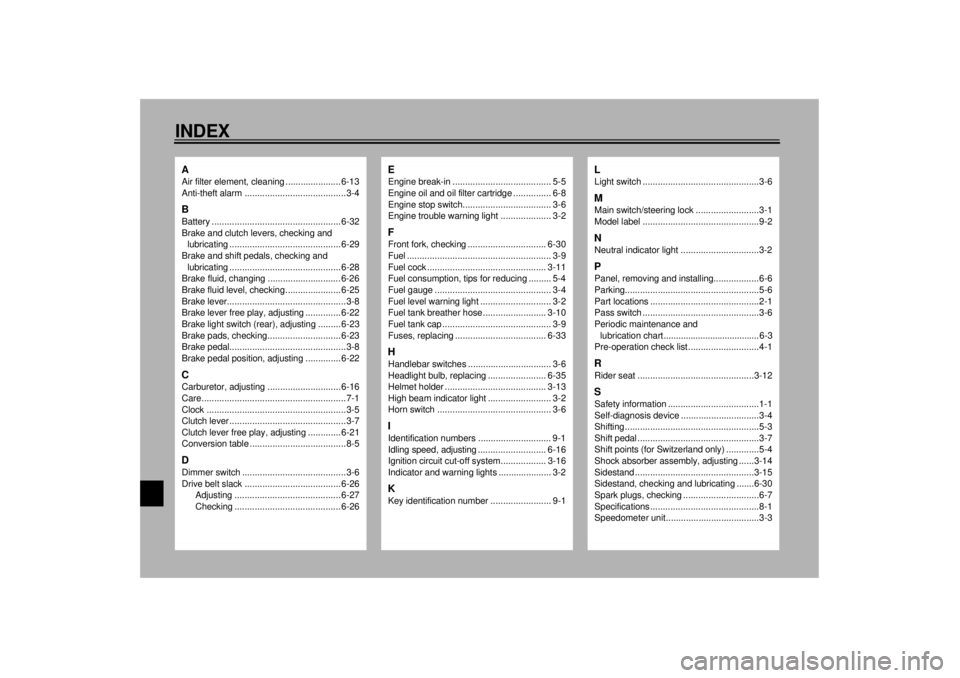
10-INDEXAAir filter element, cleaning ...................... 6-13
Anti-theft alarm ........................................3-4BBattery ................................................... 6-32
Brake and clutch levers, checking and
lubricating ............................................ 6-29
Brake and shift pedals, checking and
lubricating ............................................ 6-28
Brake fluid, changing ............................. 6-26
Brake fluid level, checking...................... 6-25
Brake lever...............................................3-8
Brake lever free play, adjusting .............. 6-22
Brake light switch (rear), adjusting ......... 6-23
Brake pads, checking............................. 6-23
Brake pedal..............................................3-8
Brake pedal position, adjusting .............. 6-22CCarburetor, adjusting ............................. 6-16
Care.........................................................7-1
Clock .......................................................3-5
Clutch lever ..............................................3-7
Clutch lever free play, adjusting ............. 6-21
Conversion table ......................................8-5DDimmer switch .........................................3-6
Drive belt slack ...................................... 6-26
Adjusting .......................................... 6-27
Checking .......................................... 6-26
EEngine break-in ....................................... 5-5
Engine oil and oil filter cartridge ............... 6-8
Engine stop switch................................... 3-6
Engine trouble warning light .................... 3-2FFront fork, checking ............................... 6-30
Fuel ......................................................... 3-9
Fuel cock ............................................... 3-11
Fuel consumption, tips for reducing ......... 5-4
Fuel gauge .............................................. 3-4
Fuel level warning light ............................ 3-2
Fuel tank breather hose ......................... 3-10
Fuel tank cap ........................................... 3-9
Fuses, replacing .................................... 6-33HHandlebar switches ................................. 3-6
Headlight bulb, replacing ....................... 6-35
Helmet holder ........................................ 3-13
High beam indicator light ......................... 3-2
Horn switch ............................................. 3-6IIdentification numbers ............................. 9-1
Idling speed, adjusting ........................... 6-16
Ignition circuit cut-off system.................. 3-16
Indicator and warning lights ..................... 3-2KKey identification number ........................ 9-1
LLight switch ..............................................3-6MMain switch/steering lock .........................3-1
Model label ..............................................9-2NNeutral indicator light ...............................3-2PPanel, removing and installing..................6-6
Parking.....................................................5-6
Part locations ...........................................2-1
Pass switch ..............................................3-6
Periodic maintenance and
lubrication chart ....................................... 6-3
Pre-operation check list ............................4-1RRider seat ..............................................3-12SSafety information ....................................1-1
Self-diagnosis device ...............................3-4
Shifting .....................................................5-3
Shift pedal ................................................3-7
Shift points (for Switzerland only) .............5-4
Shock absorber assembly, adjusting ......3-14
Sidestand ...............................................3-15
Sidestand, checking and lubricating .......6-30
Spark plugs, checking ..............................6-7
Specifications ...........................................8-1
Speedometer unit.....................................3-3
E_5JA.book Page 1 Wednesday, September 13, 2000 6:06 PM